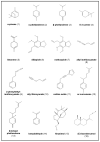Back to the Roots-An Overview of the Chemical Composition and Bioactivity of Selected Root-Essential Oils
- PMID: 34070487
- PMCID: PMC8197530
- DOI: 10.3390/molecules26113155
Back to the Roots-An Overview of the Chemical Composition and Bioactivity of Selected Root-Essential Oils
Abstract
Since ancient times, plant roots have been widely used in traditional medicine for treating various ailments and diseases due to their beneficial effects. A large number of studies have demonstrated that-besides their aromatic properties-their biological activity can often be attributed to volatile constituents. This review provides a comprehensive overview of investigations into the chemical composition of essential oils and volatile components obtained from selected aromatic roots, including Angelica archangelica, Armoracia rusticana, Carlina sp., Chrysopogon zizanioides, Coleus forskohlii, Inula helenium, Sassafras albidum, Saussurea costus, and Valeriana officinalis. Additionally, their most important associated biological impacts are reported, such as anticarcinogenic, antimicrobial, antioxidant, pesticidal, and other miscellaneous properties. Various literature and electronic databases-including PubMed, ScienceDirect, Springer, Scopus, Google Scholar, and Wiley-were screened and data was obtained accordingly. The results indicate the promising properties of root-essential oils and their potential as a source for natural biologically active products for flavor, pharmaceutical, agricultural, and fragrance industries. However, more research is required to further establish the mechanism of action mediating these bioactivities as well as essential oil standardization because the chemical composition often strongly varies depending on external factors.
Keywords: Angelica archangelica; Armoracia rusticana; Carlina sp.; Chrysopogon zizanioides; Coleus forskohlii; Inula helenium; Sassafras albidum; Saussurea costus; Valeriana officinalis; essential oils; roots.
Conflict of interest statement
The authors declare no conflict of interest.
Figures
Similar articles
-
Chemical Composition, Antioxidant, and Antimicrobial Activities of Vetiveria zizanioides (L.) Nash Essential Oil Extracted by Carbon Dioxide Expanded Ethanol.Molecules. 2019 May 17;24(10):1897. doi: 10.3390/molecules24101897. Molecules. 2019. PMID: 31108854 Free PMC article.
-
Chemical analysis and biological activity of the essential oils of two valerianaceous species from China: Nardostachys chinensis and Valeriana officinalis.Molecules. 2010 Sep 14;15(9):6411-22. doi: 10.3390/molecules15096411. Molecules. 2010. PMID: 20877232 Free PMC article.
-
Essential oil composition and antimicrobial activity of Angelica archangelica L. (Apiaceae) roots.J Med Food. 2014 Sep;17(9):1043-7. doi: 10.1089/jmf.2013.0012. Epub 2014 May 2. J Med Food. 2014. PMID: 24788027
-
Monoterpenes: Essential Oil Components with Valuable Features.Mini Rev Med Chem. 2020;20(11):958-974. doi: 10.2174/1389557520666200122144703. Mini Rev Med Chem. 2020. PMID: 31969098 Review.
-
Cytotoxic, anti-carcinogenic and antioxidant properties of the most frequent plant volatiles.Neoplasma. 2013;60(4):343-54. doi: 10.4149/neo_2013_046. Neoplasma. 2013. PMID: 23581421 Review.
Cited by
-
Composition and Activities of Carpesium macrocephalum Franch. & Sav. Essential Oils.Molecules. 2024 Sep 30;29(19):4658. doi: 10.3390/molecules29194658. Molecules. 2024. PMID: 39407585 Free PMC article.
-
Current and potential future biological uses of Saussurea costus (Falc.) Lipsch: A comprehensive review.Heliyon. 2024 Sep 11;10(18):e37790. doi: 10.1016/j.heliyon.2024.e37790. eCollection 2024 Sep 30. Heliyon. 2024. PMID: 39323795 Free PMC article. Review.
-
Phytochemical Profiles and Biological Studies of Selected Botanical Dietary Supplements Used in the United States.Prog Chem Org Nat Prod. 2023;122:1-162. doi: 10.1007/978-3-031-26768-0_1. Prog Chem Org Nat Prod. 2023. PMID: 37392311
-
Enhancement of Forskolin Production Using Aeroponic Cultivation of Coleus forskohlii and the Impact on the Plant Phytochemistry.Molecules. 2024 Sep 5;29(17):4215. doi: 10.3390/molecules29174215. Molecules. 2024. PMID: 39275064 Free PMC article.
-
Synthesis of Cyclic Fragrances via Transformations of Alkenes, Alkynes and Enynes: Strategies and Recent Progress.Molecules. 2022 Jun 2;27(11):3576. doi: 10.3390/molecules27113576. Molecules. 2022. PMID: 35684511 Free PMC article. Review.
References
-
- Figueiredo A.C., Barroso J., Pedro L., Scheffer J. Factors affecting secondary metabolite production in plants: Volatile components and essential oils. Flavour Fragr. J. 2008;23:213–226. doi: 10.1002/ffj.1875. - DOI
-
- Kala C., Ali S.S., Ahmad N., Gilani S.J., Khan N.A. Isothiocyanates: A review. Res. J. Pharmacogn. 2018;5:71–89. doi: 10.22127/RJP.2018.58511. - DOI
-
- Wnorowski A., Wnorowska S., Wojas K., Grenda A., Staniak M., Michalak A., Woźniak S., Matosiuk D., Biala G., Wójciak-Kosior M., et al. Toxicity of carlina oxide—A natural polyacetylene from the Carlina acaulis roots—In vitro and in vivo study. Toxins. 2020;12:239. doi: 10.3390/toxins12040239. - DOI - PMC - PubMed
Publication types
MeSH terms
Substances
LinkOut - more resources
Full Text Sources


